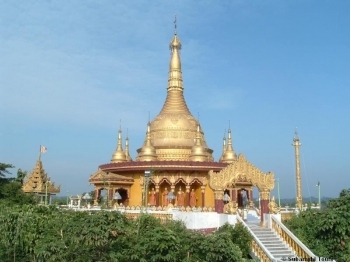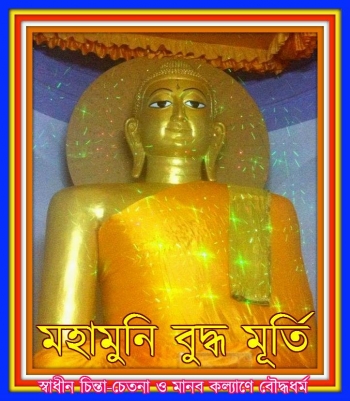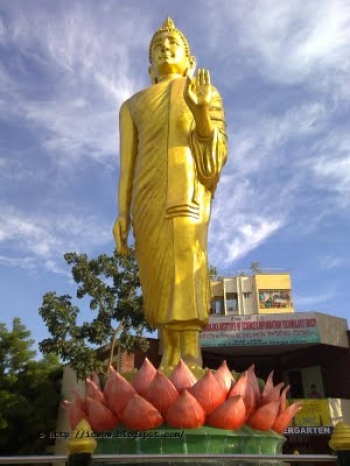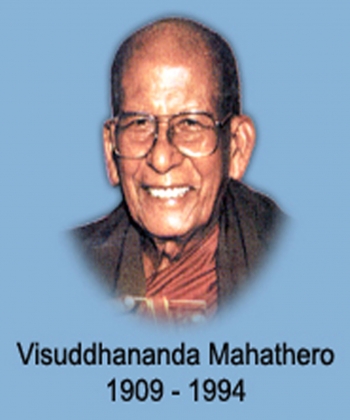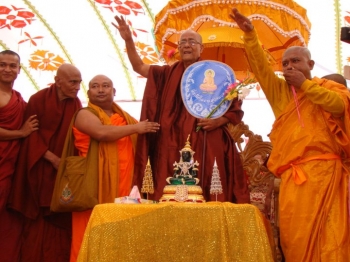In Buddhist Studies, a narrative I believe to be erroneous dominates the sub-discipline of Indo-Tibetan research. The story goes that Buddhism disappeared from the Indian subcontinent completely after the 12th century. I challenged this idea some time ago in my essay, “The Revival of Buddhism in Indo-Bangla Territory: A New Perspective”. I argued that Buddhism endured in Bengal (present-day Bangladesh), and since there was no consciousness of Bangladesh and India as nation-states until well into the 20th century, it seems sensationalist to conclude that Buddhism went extinct when it was merely localized and restricted under Islamic rule.
Whatever their intentions, European historians and archaeologists deserve some credit for the revival of Buddhism in Bangladesh. By unearthing so many Indian Buddhist manuscripts, archaeological sites, Buddhist temples, and stupas, Western Indologists restored a consciousness that, to some degree, had been suppressed since the dominance of Islam from the 12th to 18th centuries. The British colonial period motivated Bengali scholars and historians to revisit the memory of the Theravada tradition in the 18th and 19th century. Scholars wrote extensively on Buddhist history in Bengal, from Sir William Jones and Alexander Cunningham to Rajendralal Mitra, Haraprasad Shastri, Rabindranath Tagore, and Dr. Benimadhab Barua. By the early 19th century, Buddhist society in Bengal was reawakening to a renaissance that would inspire a revivalist movement throughout South Asia.
Centuries of Muslim rule seriously affected Buddhism in Bengal. Devotees abandoned their religion, culture and customs, and followed a folk religion that resembled Buddhism but was far removed from any doctrinal clarity. For example, Haraprashad Shastri wrote: “The Buddhists forgot their own religion, their philosophy and their ideals, … Their [sic] remained a group of ignorant bhikkhus or married persons in the garb of a 'bhikkhu' and they reformed Buddhism in their own way, according to their will” (Haraprasad Granthavali, p.424, [Quoted by Sukomal Chaudhuri]). However, due to the relatively liberal religious policy of the British Raj, Buddhists gradually regained a presence and re-established themselves in areas of modern Bangladesh.
During the British period, many Buddhist temples were built but the jumbled form of Buddhism remained. The ritual activities of Buddhists were also very similar to Hinduism and, as a result, the British recorded them as simply Hindus. In the late 19th century, Buddhists sent several representatives to the British government to argue that they had a separate identity.
The search for a legitimate form of Buddhism began when Ven. Cainga Thaur of Pahartali, Chittagong, visited the Mahamuni image in Arakan With the help of Arakan architects he designed a replica of the original image and built it in his native village at Pahartali in 1813. After the establishment of the Mahamuni image, His Holiness Saramedha Mahathera came to Chittagong in 1856 to teach. In this sense, the Mahamuni image can be seen as instrumental in the reinstatement of Theravada Buddhism as a tradition in Bengal.
When he arrived in Chittagong, Ven. Saramedha Mahathera was disappointed by Buddhism’s poor conditions. He encouraged Buddhists to give up the worship of Hindu gods and goddesses as well as remnants of Tantric practice left over from the Pala era, when Bengal was a hub for Tantric activity and adepts. Many monks who observed the spurious practices decided to receive higher ordination under Ven. Saramedha's supervision. He returned to Chittagong in 1864, accompanied by many professional monks to lead the higher ordination for those who wanted it. The newly ordained monks established a new monastic lineage called the Sangharaja Nikaya, now known as the Sangharaj Bhikkhu Mahasabha (the Supreme Sangha Council of Bangladesh), and Ven. Saramedha was its first Sangharaja.
However, some monks known as Mather Dali did not receive ordination under the leadership of Ven. Saramedha and are now called Mahasthavir Nikaya. At present they also refer to their organization as the Supreme Buddhist Sangha Council of Bangladesh. Apart from these two organizations, there are other Buddhist Sangha Councils among the ethnic Chakma and Marma monks in the Chittagong Hill Tracts.
The Buddhist revivalists established many Buddhist temples, Pali institutions, schools, and organizations. Many Buddhist books, papers, magazines, and newsletters were published. Some respected monks made outstanding contributions: Radhacaran Mahathera, Purnachar Mahathera, Praggalok Mahathera, Dharmadhar Mahathera, Aggavamsa Mahathera, Visuddhananda Mahathera, and Sadhanananda Mahathera are only a few. The contribution of Bengalis like Venerable Kripasaran Mahathera also aided Buddhism’s revival on the ground. In 1972, the World Fellowship of Buddhists recognized Venerable Kripasaran as a pioneer in the Indian Buddhist revival.
Some organizations have played a vital role in propagating Buddhism. The Chittagong Buddhist Association was established in 1887 and was a leading organization. It is now known as the Bangladesh Buddhist Association. Nazir Krishna Chowdhury established the group to represent the Buddhist community to the British government. Ven. Kripasaran Mahathera, a Buddhist pioneer, established the Bengal Buddhist Association in Calcutta in 1892. This association has played an important role in reviving Buddhism, not only in Bengal but throughout India. Rev. Anagarika Dhammapala came from Sri Lanka to Calcutta and founded the Mahabodhi Society of India in 1891, perhaps the most famous of the revivalist groups. A similar organization, the Bangladesh Bauddha Kristi Prachar Sangha, was established in Dhaka in 1950 by Ven. Visuddhananda Mahathera.
There are also some important lay Buddhists who have enormously contributed to the development of a Buddhist society. Among them are Chakama Queen Kalindi Rani, Umesh Chandra Barua, Umesh Chandra Mutsuddi and Fanibhushan Barua. But that is an inspiration for another day.
As part of the Indian subcontinent, Bangladesh was an important crucible for the modern restoration of South Asian Buddhism. Political disturbances and oppression led Buddhism to decline from the 13th century to the 17th century. Buddhism achieved its first revival under British rule, and the weight of European scholarship influenced the revivalists to embrace Theravada. Nevertheless, social revitalization remains necessary for Buddhists to ensure continuity in Bangladesh.
Related Link
References
Berkwitz, S.C. (2010). South Asian Buddhism: A Survey. New York: Routledge.
Chaudhuri, S. (1982). Contemporary Buddhism in Bangladesh. Calcutta: Atisha Memorial Publishing Society.
Chowdhury, H.B. (2010). Buddha Dharmankur Sabha (Bengal Buddhist Association): At a Glance. Kolkata: Buddha Dharmankur Sabha.
Sastri, H. (1897). Discovery of Living Buddhism in Bengal. Sanskrit Press Depository.
Singh, S.D. (1991). Revival and Development of Buddhism in India.Mahabodhi Society Centenary Celebrations. Vol. 2. Buddhagaya Centre, India.
